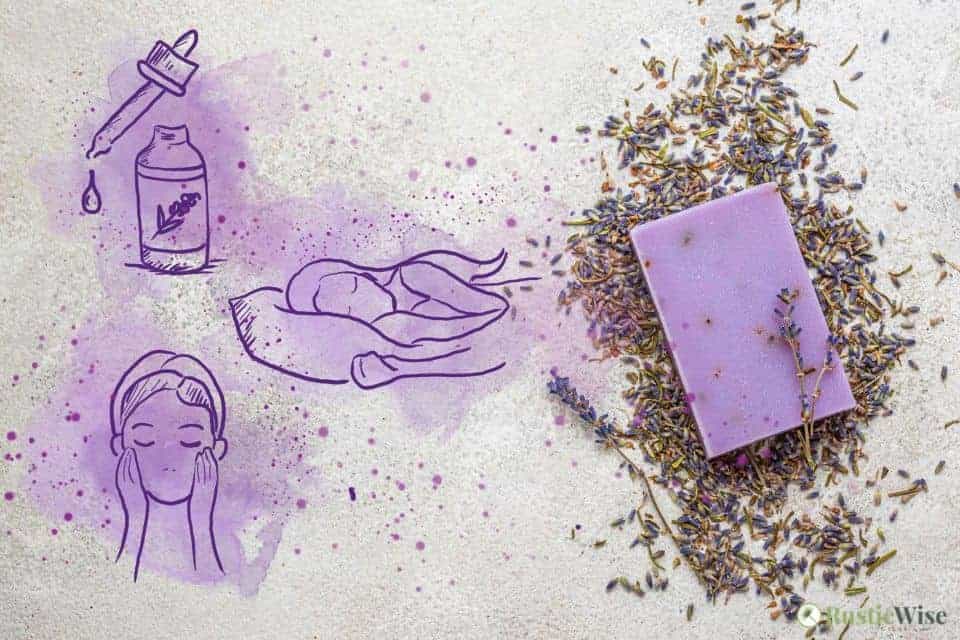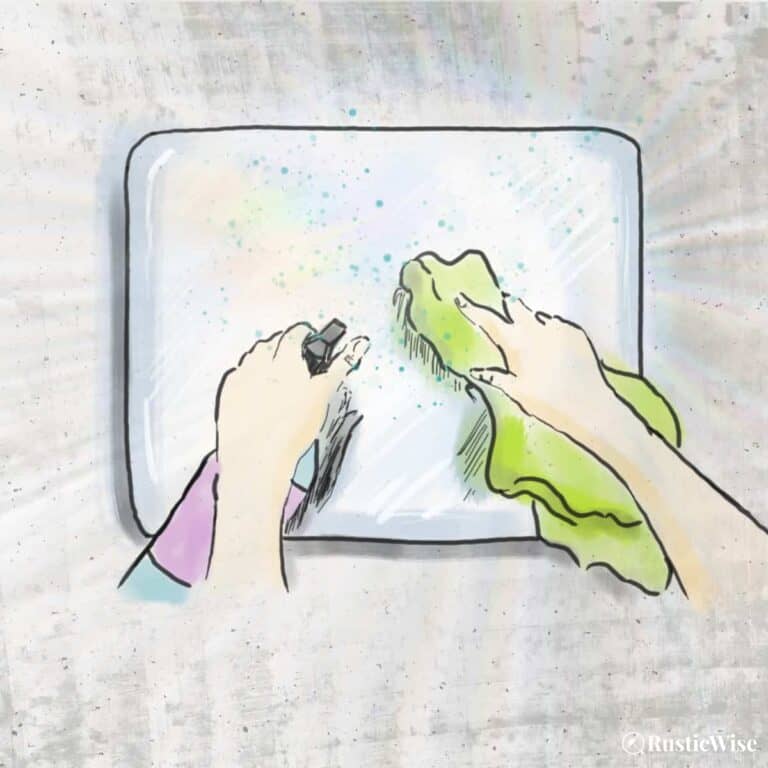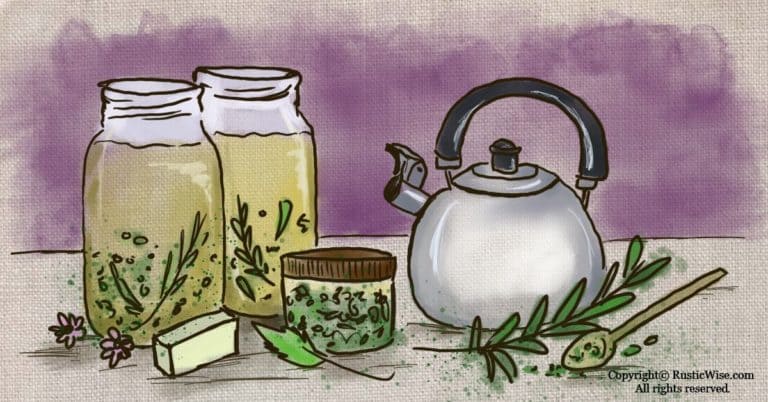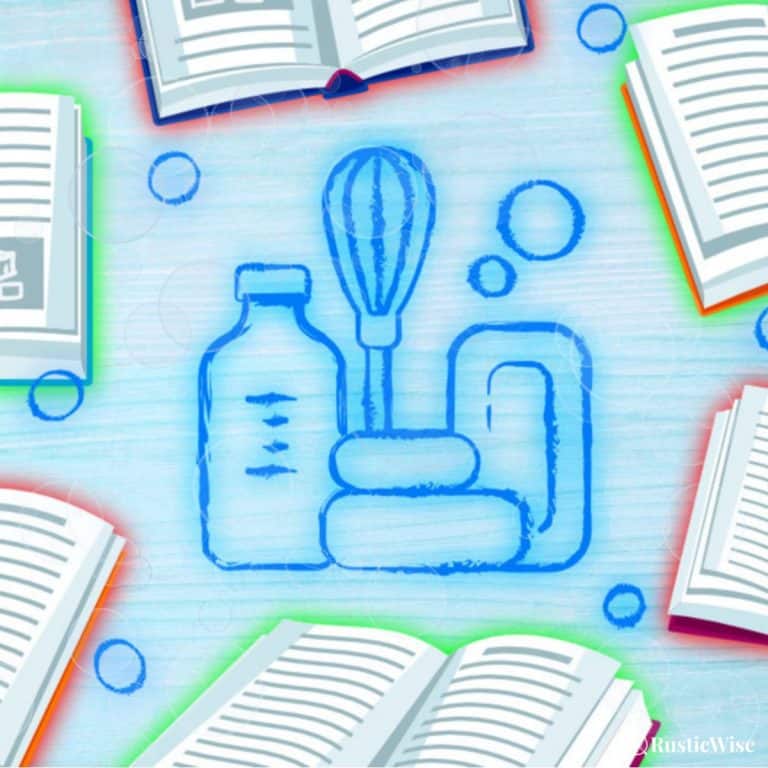Lavender Soap Benefits: How To Get the Most Out of This Healing Herb
RusticWise is supported by its readers. When you purchase through links on our site, we may earn an affiliate commission. As an Amazon Associate, we earn from qualifying purchases. Thank You!
Much more than just another pretty bloom, the lavender plant contains medicinal and therapeutic properties.
Lavender essential oils offer aromatherapy properties that help you relax. This purple flower is also a popular additive to homemade soap. The flowers and essential oil bring on plenty of lavender soap benefits with antimicrobial and antiseptic properties that soothe and heal skin. This makes lavender soap great for acne, eczema, or inflammation.
Read on to learn more about the power of lavender, its uses and benefits for body and skin, lavender soap benefits, and how to make your own handcrafted soap with lavender and oatmeal.
Lavender 101: a quick introduction to this medicinal plant
Lavender, from the genus Lavandula, comprises over 30 different species. It originates in areas by the Mediterranean Sea in Europe (particularly England and France), Africa, and parts of southwest Asia and southeast India.¹
While there are many types of lavender, most varieties share similar qualities. The four main types of lavender are:
- English lavender (L. angustifolia; formerly known as L. officinalis): A cold-resistant variety that’s sometimes called true lavender, or common lavender.
- French lavender (L. stoechas): A popular aromatic variety.
- Spike lavender (L. latifolia): A Mediterranean variety with grassy foliage, sometimes called Portuguese lavender.
- Lavandin, Lavandula x intermedia (L. intermedia): A hybrid cross between English lavender and spike lavender that grows larger and produces more flowers.
The major active constituents of the lavender plant include:¹
- Linalool
- Linalyl acetate
- 1,8-cineole B-ocimene
- Terpinen-4-ol
- Camphor
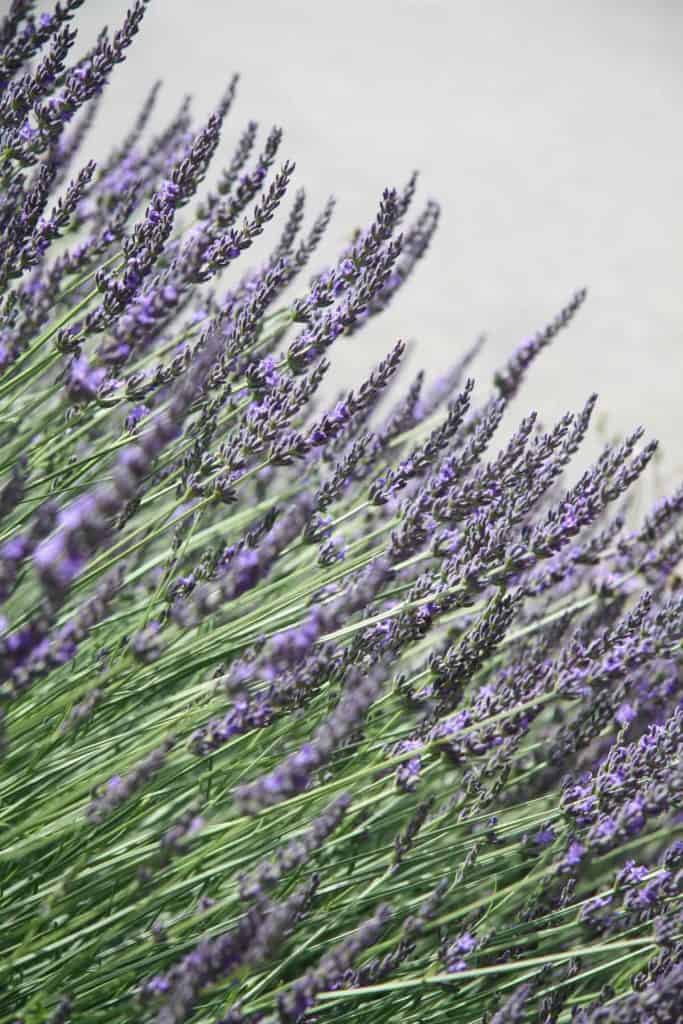
Credit: Yay Images
What does lavender smell like?
Most people would describe the lavender as a floral scent with earthy or herbal undertones which prevent it from smelling overwhelming or overly floral.
While most people would find the aroma of lavender pleasing, insects don’t agree. Lavender has insect repellant properties.
Lavender uses and benefits
What is lavender used for, exactly? There’s a reason this plant is so popular amongst herbalists, soap makers, and anyone who appreciates aromatherapy—it’s a versatile botanical with soothing properties.
Lavender uses
- Natural soap: Dried purple flowers are used as a homemade soap additive. It’s best to sprinkle on top of soap as lye turns these purple blooms brown.
- Aromatherapy: The steam extracted oils from the petals are used to create lavender essential oil. A few whiffs of this potent liquid in an air diffuser can help you kick back and relax after a long day’s work.
- Massage oil: Dilute a few drops of lavender EO into a carrier oil and massage onto sore muscles, aches, and pains.
- Lotions and other skincare products: Lavender EO can enhance the aroma and therapeutic properties of your DIY body lotions, body washes, or facial cleansers.
- Natural cleaning solutions: A few drops of lavender EO adds antiseptic and antibacterial properties. This, combined with its pleasant aroma makes it a cleaning powerhouse.
- Potpourri: Enjoy the dried petals in a homemade potpourri. The scent of this purple flower can also lull you into a restful sleep. Check out how to make your own herbal sleep pillow.
- Tea: Brew a cup of tea with fresh or dried lavender buds to get you ready for bed.
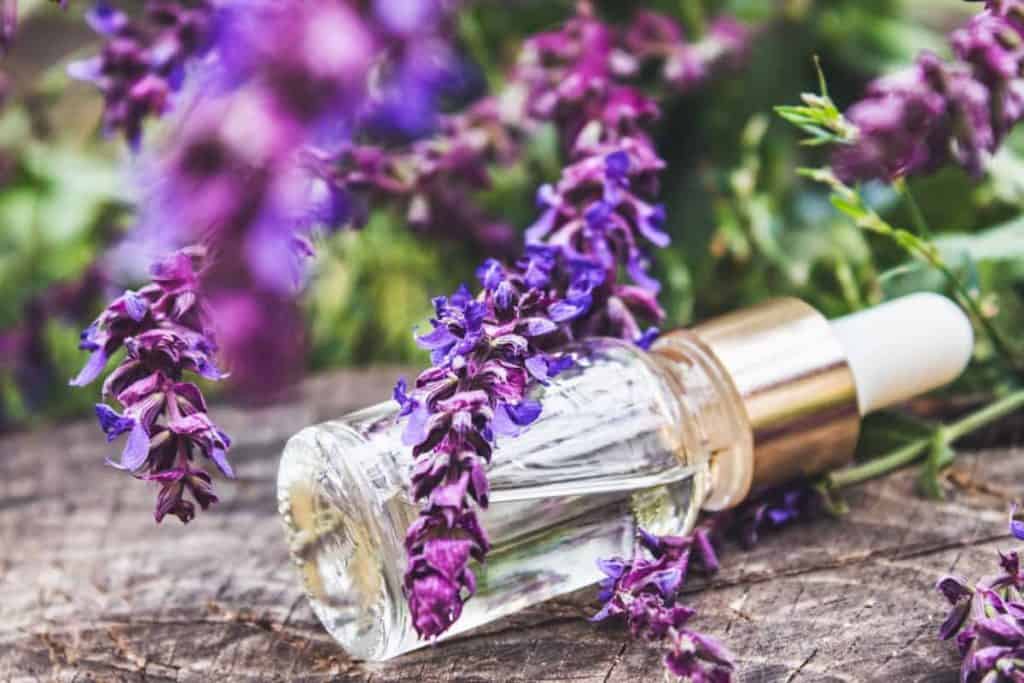
Credit: Vector State
Lavender oil benefits
Improves anxiety, depression, and overall mood
Lavender has been proven to soothe the nervous system, lower blood pressure—all of which serve to boost overall mood.²
Soothes pain and inflammation
The next time you have a headache, you could try some lavender aromatherapy. One 2012 study shows that patients with migraine headaches who inhaled lavender EO during aromatherapy experienced less severe pain.³ If you have sore muscles or achy joints, add a few drops of lavender EO to a massage oil and apply directly to the area of pain.
Antiseptic, antimicrobial, and antiviral properties
Lavender contains antiseptic, antimicrobial, and antiviral properties which may kill some bacteria and viruses.² This is why you’ll often find lavender EO as in ingredient in DIY household cleaners.
With these unique properties, perhaps it’s no surprise that lavender is used to promote healing of wounds. This makes it a great addition to homemade soap recipes, and other natural skincare products.
Reduces stress and improves sleep quality
With the hectic lifestyles many of us lead, we could all use a stress-buster and natural sleep aid. It turns out this healing herb provides just that.
A 2017 study studied the levels of stress and quality of sleep in intensive care patients after using lavender oil as aromatherapy.⁴ Results show that after just two days of experimental treatment, patients reported lower stress levels (both self-perceived and via objective indexes), lower blood pressure and heart rate, and better sleep quality.
May help with restless leg syndrome (RLS)
Restless leg syndrome (RLS) often goes hand-in-hand with patients that have chronic renal failure. One study in 2014 studied the effects of lavender massage oil on hemodialysis patients who also suffered from RLS.⁵
Results show the application of lavender infused massage oil directly to the problem area eased RLS and showed no adverse side effects. It also proved to be economical and easy to apply.
May promote hair growth
While we need more studies on human subjects in this area, a promising 2016 study performed on female mice shows lavender oil has potential hair growth promoting agents.
The female mice who received lavender oil treatment showed an increase in, “hair follicle number, dermal thickness, and hair follicle depth.”⁶
Lavender soap benefits
One of the most popular ways to reap the benefits of this healing plant is to add it to soap.
There are a few different ways you can reap the rewards of lavender soap benefits. Most commonly, soap makers add a small percentage of lavender EO to the soap batter. You can also sprinkle dried lavender buds on top as a decorative element. Or, you can infuse the oils, or create lye water tea with the petals.
The big questions is, do any of the benefits of lavender transfer over to the finished soap? After all, the homemade soap making process (either cold process or hot process) is subject to high temperatures, and the high alkalinity of lye can gobble up much of the therapeutic benefits of most oils.
I haven’t found any scientific studies on this yet.
While the jury is still out, most soap makers would agree that there seems to be a difference in the finished soap when using lavender. At the very least, you can enjoy the beautiful scent of lavender that has proven aromatherapy benefits!
So, bring that bar of lavender bath soap into the shower as part of your evening ritual.
Here are a few benefits of lavender soap.
Relaxing and soothing
We mentioned above how lavender EO can soothe the nervous system and boost your mood. Enjoy the natural scent of this healing herb in the bath or shower before bedtime. You may notice a better night’s sleep, too!
Helps with acne, eczema, and skin inflammation
The antiseptic and antimicrobial properties of lavender EO are great for treating a wide range of skin conditions, including acne, eczema, and skin inflammation.
When applied topically as a soap bar, this medicinal plant may help to reduce redness and skin blemishes.
Healing properties
Cuts or broken skin may benefit from a gentle topical application of lavender soap. Lavender may help promote wound healing.
Gentle cleanser
Unlike many commercial facial cleansers or body washes, this healing herb helps to gently cleanse the skin without stripping it of its natural, healthy oils.
Is lavender good for everyone?
While lavender and its essential oils are a perennial favorite amongst soap makers and natural care enthusiasts, some people may experience allergic reactions when using lavender products. Some develop rashes (contact dermatitis).
Essential oils contain volatile compounds which imbue them with therapeutic properties. Like all essential oils, lavender should be used with caution in diluted amounts, or with a carrier oil.
While lavender EO is generally safe for most skin types, it’s always a good idea to perform a small 24 hour patch test on skin first.
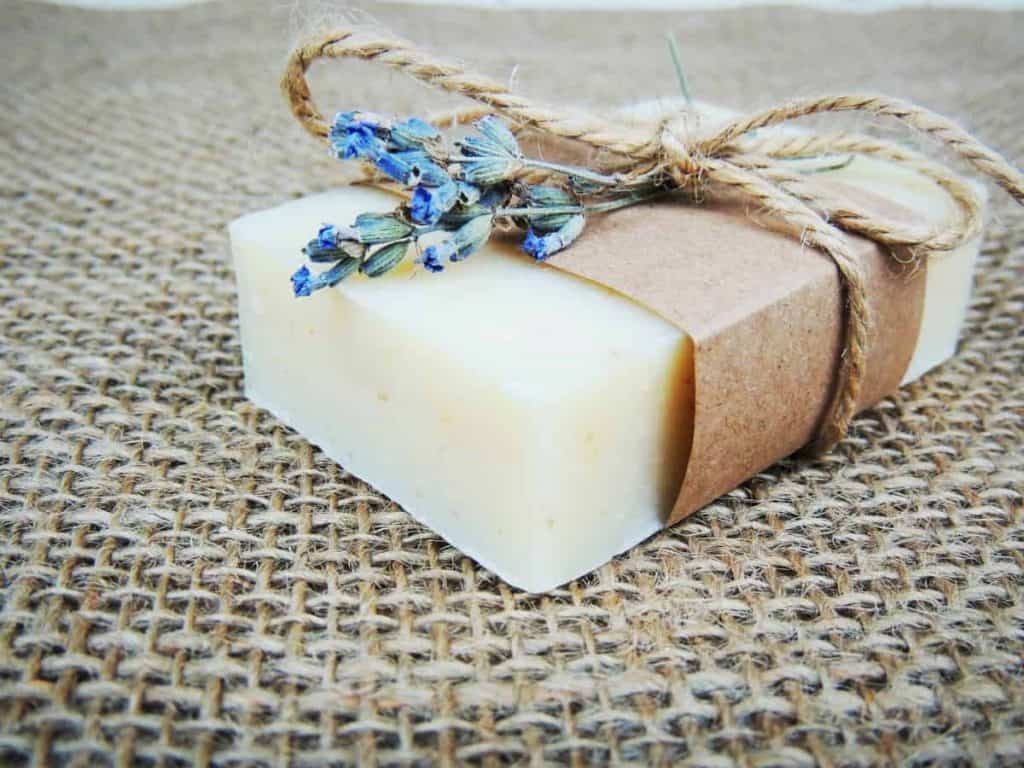
Credit: Deposit Photos
Soothing lavender and oatmeal soap recipe
Great for dry skin, or sensitive skin, here’s an oatmeal lavender soap recipe that combines the healing properties of lavender with the gently exfoliating and calming qualities of finely ground oats.
If this is the first time you’ve made cold process soap, please read up on lye safety first!
The following recipe is adapted from Alicia Grosso’s The Everything Soapmaking Book.
Yield: 1-pound batch, or roughly 4 bars of soap
Supplies you’ll need:
- Digital kitchen scale
- Thermometer (digital, infrared, or candy thermometer)
- Immersion blender (stick blender)
- Stainless steel saucepan for melting the lard
- Heat-safe jug for the lye solution
- Rubber spatula for stirring and scraping
- Loaf mold or individual silicone molds
- Wax paper or piece of cardboard to cover the soap mold
- Old towels to insulate the soap mold
- Safety gear (goggles and gloves)
Ingredients:
Lye solution:
- 2.4 ounces of sodium hydroxide lye
- 5 ounces distilled water
Hard oils:
- 5.25 ounces of coconut oil
Soft oils:
- 10.5 ounces olive oil
- 0.5 ounces castor oil
Fragrances and additives:
- 0.5 ounces lavender essential oil
- 1 tablespoon finely ground oats
- 1 tablespoon dried lavender flowers (optional)
- Prepare the lye mixture. Put your safety gear on (your lye mixture will get extremely hot). Measure the distilled water and add to heat-safe jug. Measure the sodium hydroxide and slowly add to water (NOT the other way around). Let the lye mixture to cool.
- Measure and heat hard oils in a saucepan. Warm the coconut oil over low heat in a stainless steel saucepan until melted, stirring occasionally. Remove from heat.
- Measure soft oils and combine. Measure the rest of the soft oils and combine with the melted coconut oil.
- Combine lye with oils and bring to trace. Once the lye mixture has cooled and is of similar temperature to the combined oils, carefully add the lye to the oils. A good temperature is somewhere around 110 degrees Fahrenheit (43 degrees Celsius). Use an immersion blender (stick blender) to combine the soap batter until it thickens and turns opaque (reaches trace).
- Add fragrances and additives at trace. Once your soap batter has reached trace, add your essential oil, and ground oats. Hand stir to combine.
- Pour into mold. Pour the soap batter into a prepared mold. Optional: once you’ve poured the soap, you can choose to sprinkle dried lavender buds to the top of the soap down the center. Cover with wax paper or a piece of cardboard. Wrap some old towels to insulate the soap.
- Set, cut, and cure. Allow the soap batter to cool and harden (at least 24 hours). If soap has hardened, unmold and cut into bars. If bars are too soft, allow it to set for several more days. Let the soap bars cure for 3 to 4 weeks in a well-ventilated room. You’ll get a longer lasting bar this way.
Enjoy your soothing, handmade lavender soap!
New to making soap? 🧼❓
👉We have a fantastic overview on the whole soapmaking process here: read our Timeless Guide To Soapmaking.
If you would like to see our soapmaking posts organized by topic type, see our Soapmaking Collection.
Would you like more timeless tips via email?
Fun tips to help you live an independent, self-sustaining lifestyle. Opt-out at any time.


References
- Koulivand, P. H., Khaleghi Ghadiri, M., & Gorji, A. (2013). Lavender and the nervous system. Evidence-based complementary and alternative medicine : eCAM, 2013, 681304. https://doi.org/10.1155/2013/681304
- Cleveland Clinic, How Lavender Can Improve Your Health, https://health.clevelandclinic.org/health-benefits-of-lavender/. Accessed March 2022.
- Sasannejad, P., Saeedi, M., Shoeibi, A., Gorji, A., Abbasi, M., & Foroughipour, M. (2012). Lavender essential oil in the treatment of migraine headache: a placebo-controlled clinical trial. European neurology, 67(5), 288–291. https://doi.org/10.1159/000335249
- Cho, E. H., Lee, M. Y., & Hur, M. H. (2017). The Effects of Aromatherapy on Intensive Care Unit Patients’ Stress and Sleep Quality: A Nonrandomised Controlled Trial. Evidence-based complementary and alternative medicine : eCAM, 2017, 2856592. https://doi.org/10.1155/2017/2856592
- Hashemi, S. H., Hajbagheri, A., & Aghajani, M. (2015). The Effect of Massage With Lavender Oil on Restless Leg Syndrome in Hemodialysis Patients: A Randomized Controlled Trial. Nursing and midwifery studies, 4(4), e29617. https://doi.org/10.17795/nmsjournal29617
- Lee, B. H., Lee, J. S., & Kim, Y. C. (2016). Hair Growth-Promoting Effects of Lavender Oil in C57BL/6 Mice. Toxicological research, 32(2), 103–108. https://doi.org/10.5487/TR.2016.32.2.103
- Grosso, Alicia (2013). The Everything Soapmaking Book, 3rd Edition. Adams Media. pp. 182–183. ISBN 13: 978-1-4405-5013-3.

Author: Theresa Tesolin
Theresa is co-founder of RusticWise. She helps people unleash their inner DIY spirit by encouraging them to get dirty and make or grow something from scratch.

